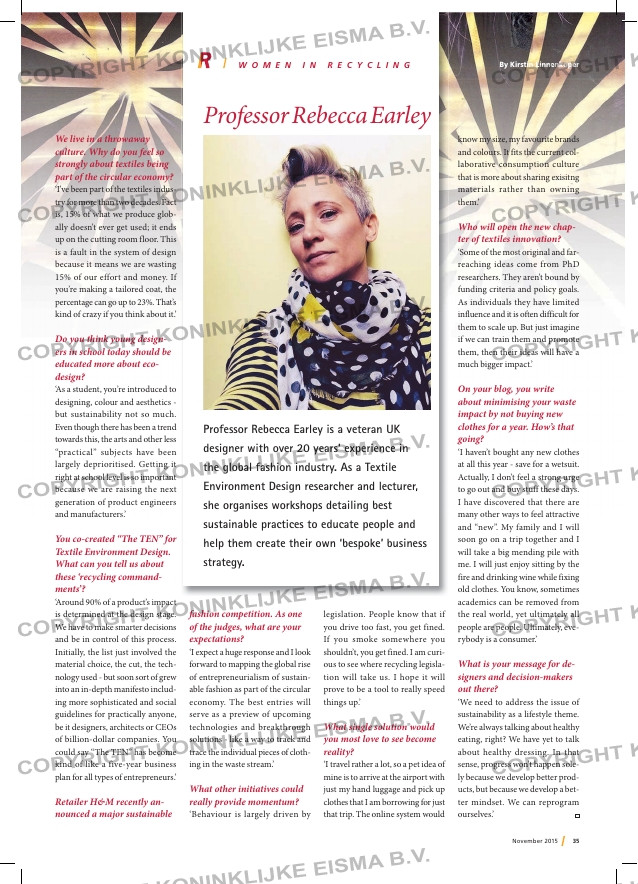Page 37 from: November 2015

35November 2015
We live in a throwaway
culture. Why do you feel so
strongly about textiles being
part of the circular economy?
‘I’ve been part of the textiles indus-
try for more than two decades. Fact
is, 15% of what we produce glob-
ally doesn’t ever get used; it ends
up on the cutting room floor. This
is a fault in the system of design
because it means we are wasting
15% of our effort and money. If
you’re making a tailored coat, the
percentage can go up to 23%. That’s
kind of crazy if you think about it.’
Do you think young design-
ers in school today should be
educated more about eco-
design?
‘As a student, you’re introduced to
designing, colour and aesthetics –
but sustainability not so much.
Even though there has been a trend
towards this, the arts and other less
“practical” subjects have been
largely deprioritised. Getting it
right at school level is so important
because we are raising the next
generation of product engineers
and manufacturers.’
You co-created “The TEN” for
Textile Environment Design.
What can you tell us about
these ‘recycling command-
ments’?
‘Around 90% of a product’s impact
is determined at the design stage.
We have to make smarter decisions
and be in control of this process.
Initially, the list just involved the
material choice, the cut, the tech-
nology used – but soon sort of grew
into an in-depth manifesto includ-
ing more sophisticated and social
guidelines for practically anyone,
be it designers, architects or CEOs
of billion-dollar companies. You
could say “The TEN” has become
kind of like a five-year business
plan for all types of entrepreneurs.’
Retailer H&M recently an-
nounced a major sustainable
fashion competition. As one
of the judges, what are your
expectations?
‘I expect a huge response and I look
forward to mapping the global rise
of entrepreneurialism of sustain-
able fashion as part of the circular
economy. The best entries will
serve as a preview of upcoming
technologies and breakthrough
solutions – like a way to track and
trace the individual pieces of cloth-
ing in the waste stream.’
What other initiatives could
really provide momentum?
‘Behaviour is largely driven by
legislation. People know that if
you drive too fast, you get fined.
If you smoke somewhere you
shouldn’t, you get fined. I am curi-
ous to see where recycling legisla-
tion will take us. I hope it will
prove to be a tool to really speed
things up.’
What single solution would
you most love to see become
reality?
‘I travel rather a lot, so a pet idea of
mine is to arrive at the airport with
just my hand luggage and pick up
clothes that I am borrowing for just
that trip. The online system would
know my size, my favourite brands
and colours. It fits the current col-
laborative consumption culture
that is more about sharing exisitng
materials rather than owning
them.’
Who will open the new chap-
ter of textiles innovation?
‘Some of the most original and far-
reaching ideas come from PhD
researchers. They aren’t bound by
funding criteria and policy goals.
As individuals they have limited
influence and it is often difficult for
them to scale up. But just imagine
if we can train them and promote
them, then their ideas will have a
much bigger impact.’
On your blog, you write
about minimising your waste
impact by not buying new
clothes for a year. How’s that
going?
‘I haven’t bought any new clothes
at all this year – save for a wetsuit.
Actually, I don’t feel a strong urge
to go out and buy stuff these days.
I have discovered that there are
many other ways to feel attractive
and “new”. My family and I will
soon go on a trip together and I
will take a big mending pile with
me. I will just enjoy sitting by the
fire and drinking wine while fixing
old clothes. You know, sometimes
academics can be removed from
the real world, yet ultimately all
people are people. Ultimately, eve-
rybody is a consumer.’
What is your message for de-
signers and decision-makers
out there?
‘We need to address the issue of
sustainability as a lifestyle theme.
We’re always talking about healthy
eating, right? We have yet to talk
about healthy dressing. In that
sense, progress won’t happen sole-
ly because we develop better prod-
ucts, but because we develop a bet-
ter mindset. We can reprogram
ourselves.’
W O M E N I N R E C Y C L I N G
Professor Rebecca Earley
Professor Rebecca Earley is a veteran UK
designer with over 20 years’ experience in
the global fashion industry. As a Textile
Environment Design researcher and lecturer,
she organises workshops detailing best
sustainable practices to educate people and
help them create their own ‘bespoke’ business
strategy.
By Kirstin Linnenkoper



